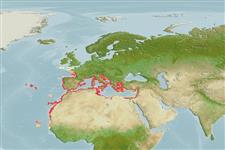Classification / Names
Common names from other countries
Main reference
Size / Weight / Age
Max length : 70.0 cm TL male/unsexed; (Ref. 57391); common length : 30.0 cm TL male/unsexed; (Ref. 3397)
Environment
Marine; brackish; pelagic-neritic; depth range 30 - ? m (Ref. 5990)
Climate / Range
Subtropical, preferred 19°C (Ref. 107945); 51°N - 10°N
Distribution
Short description
Dorsal
spines
(total): 9 - 10;
Dorsal
soft rays
(total): 12-14;
Anal
spines: 3;
Anal
soft rays: 10 - 12. Diagnosis: elongate fish with 2 separate dorsal fins and a rather deep caudal peduncle; vomerine teeth patch anchor-shaped, with the posterior teeth extending to the midline of palate; scales on interorbital space ctenoid; opercle with 2 flat spines; lower preopercular margin with large, forward-pointing spines; caudal fin moderately forked; scales small (Ref. 57391).
Coloration: silvery grey, back bluish in life; juveniles and adults with small dark markings scattered over back and sides; a very distinct black spot on opercle (Ref. 57391).
IUCN Red List Status (Ref. 115185)
Threat to humans
Harmless
Human uses
Fisheries: minor commercial; gamefish: yes
More information
ReferencesAquacultureAquaculture profileStrainsGeneticsAllele frequenciesHeritabilityDiseasesProcessingMass conversion
Tools
Special reports
Download XML
Internet sources
Estimates of some properties based on models
Phylogenetic diversity index
PD50 = 0.7656 many relatives (e.g. carps) 0.5 - 2.0 few relatives (e.g. lungfishes)
Trophic Level
3.9 ±0.65 se; Based on food items.
Resilience
Medium, minimum population doubling time 1.4 - 4.4 years (K=0.07-0.16)
Vulnerability
High to very high vulnerability (67 of 100)
Price category
